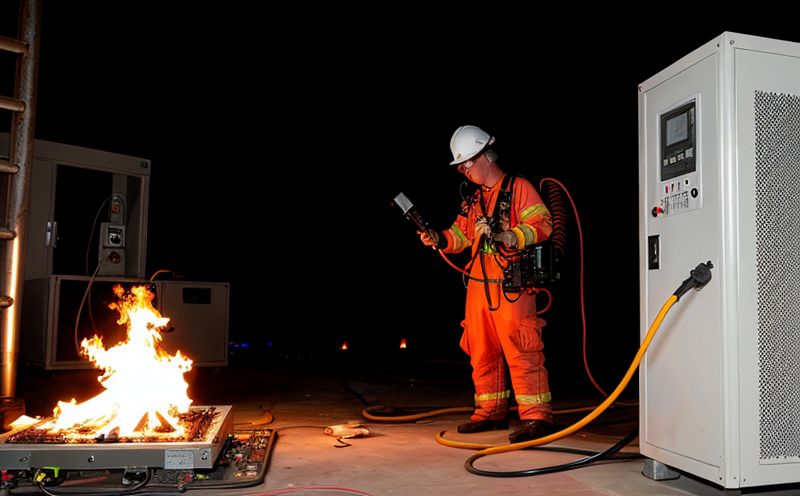Smoke and Gas Analysis for Electrical Device Fires
The analysis of smoke and gases produced during electrical device fires is essential for understanding the composition and toxicity of these emissions. This service focuses on providing comprehensive data that can inform critical design decisions, compliance assessments, and safety improvements in the development and manufacturing processes of electrical and electronic equipment (EEE).
Smoke and gas samples are collected from various sources such as laboratory simulations of fire events or real-world incidents involving electrical devices. The analysis helps identify the types of gases produced, their concentrations, and the presence of toxic compounds that can pose health risks to individuals exposed during fires.
The testing process involves the use of advanced analytical instruments including Gas Chromatography-Mass Spectrometry (GC-MS), Fourier Transform Infrared Spectroscopy (FTIR), and other chromatographic techniques. These tools allow for precise identification and quantification of the gases produced, providing detailed information on the combustion products generated by different materials and components used in electrical devices.
For quality managers and compliance officers, this service is vital to ensure that their products meet stringent safety standards such as those outlined in ISO 8617:2017, which specifies requirements for fire tests of electrically operated household equipment. R&D engineers can leverage the insights gained from this testing to innovate safer designs and materials for EEEs.
The data generated through this analysis is crucial for understanding how specific components contribute to the overall emissions profile during a fire event. This information helps in making informed decisions about material selection, circuit design, and enclosure construction to minimize harmful effects on people and property.
Smoke and gas analysis also plays an important role in forensic investigations by providing evidence of what types of materials were involved in a particular fire incident. This can be particularly useful in determining the cause of fires involving electrical devices, which is critical for preventing future incidents and ensuring product liability.
In summary, smoke and gas analysis for electrical device fires offers valuable insights into the combustion behavior of EEEs under extreme conditions. By analyzing these emissions, manufacturers and designers can ensure that their products are not only functional but also safe and compliant with relevant international standards.
Benefits
The benefits of conducting smoke and gas analysis for electrical device fires extend across multiple stakeholders involved in the design, manufacturing, and safety assessment processes. These include:
- Enhanced Safety: Understanding the composition of gases produced during a fire can help identify potential hazards and inform modifications to designs that reduce these risks.
- Compliance Assurance: Data from this analysis ensures compliance with international standards like ISO 8617, which is crucial for market access and product safety.
- Innovation Opportunities: Insights into the combustion characteristics of materials can drive innovation in safer and more efficient EEEs.
- Fault Identification: By analyzing gases produced during fire events, potential fault points in electrical devices can be identified for further investigation and rectification.
Industry Applications
| Industry Sector | Application |
|---|---|
| Furniture Manufacturing | Evaluation of flame retardants and other fire safety additives used in furniture components. |
| Data Centers | Analysis of gases produced by server racks during potential fire scenarios to ensure proper cooling systems are in place. |
| Automotive Industry | Determining the impact of electrical fires on vehicle interiors and developing safer passenger compartments. |
| Consumer Electronics Manufacturing | Evaluation of materials used in consumer electronics to minimize toxic emissions during a fire event. |
| Building Materials Sector | Testing the flammability characteristics of insulation materials and other building components used near electrical wiring. |
Why Choose This Test
Selecting this service for smoke and gas analysis offers several advantages over alternative methods. Firstly, it provides a comprehensive picture of the combustion behavior of electrical devices under fire conditions, which is essential for understanding the risks associated with specific materials and designs.
The use of advanced analytical instruments ensures high accuracy and reliability in identifying even trace amounts of toxic compounds present in smoke and gases produced during fires. This precision is critical for making informed decisions about material selection and design improvements that enhance safety without compromising performance.
Moreover, the results from this analysis can be used to compare different versions of a product or alternative materials, allowing for objective evaluation of their fire safety characteristics. This capability supports continuous improvement efforts aimed at reducing risks associated with electrical fires.
The data generated through this testing process is valuable not only during initial development stages but also throughout the lifecycle of a product. It can be used to monitor changes in fire behavior over time, ensuring ongoing compliance and safety standards are maintained.
By choosing smoke and gas analysis for electrical device fires, stakeholders gain access to detailed information that enables better decision-making processes related to product design, manufacturing practices, and overall quality assurance protocols.





